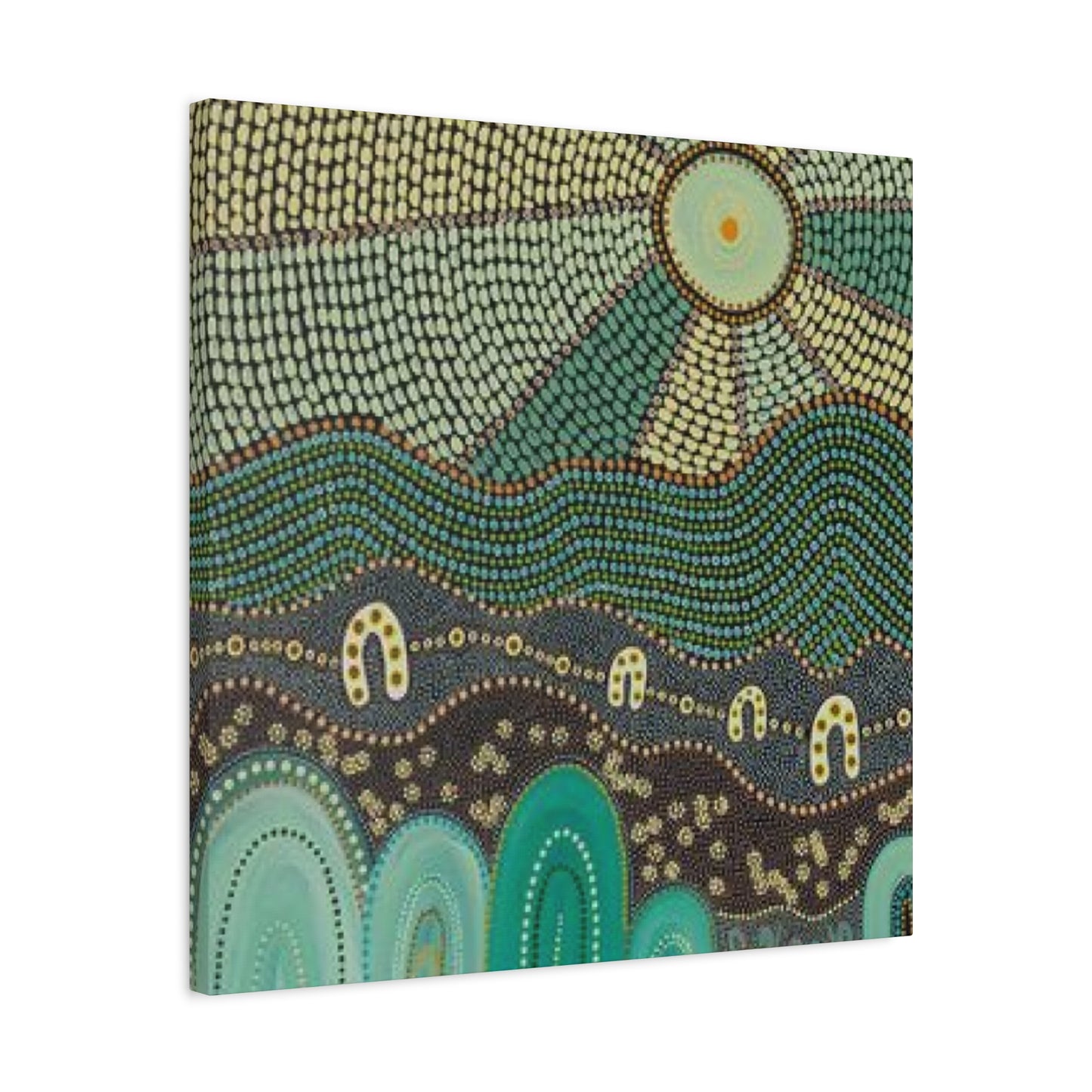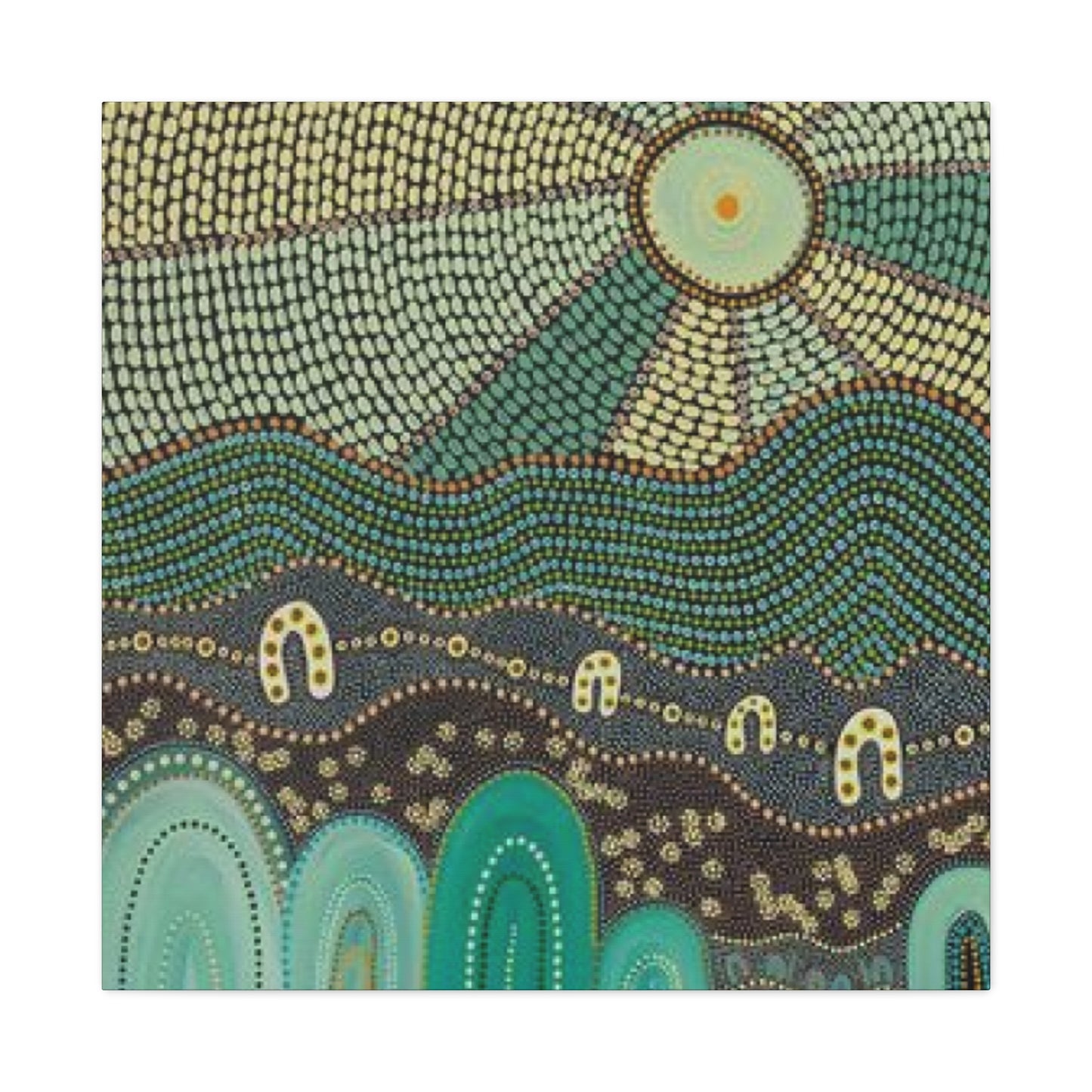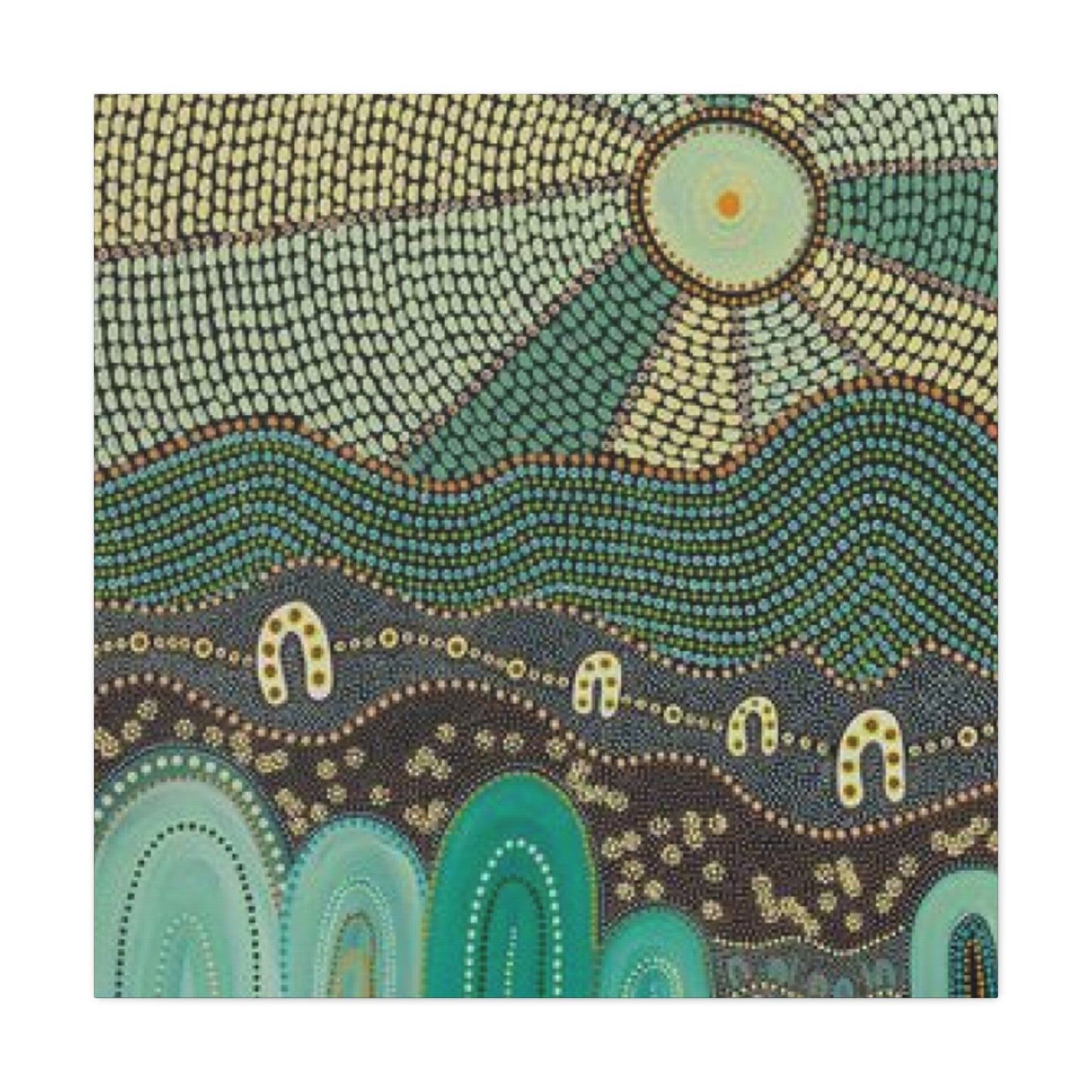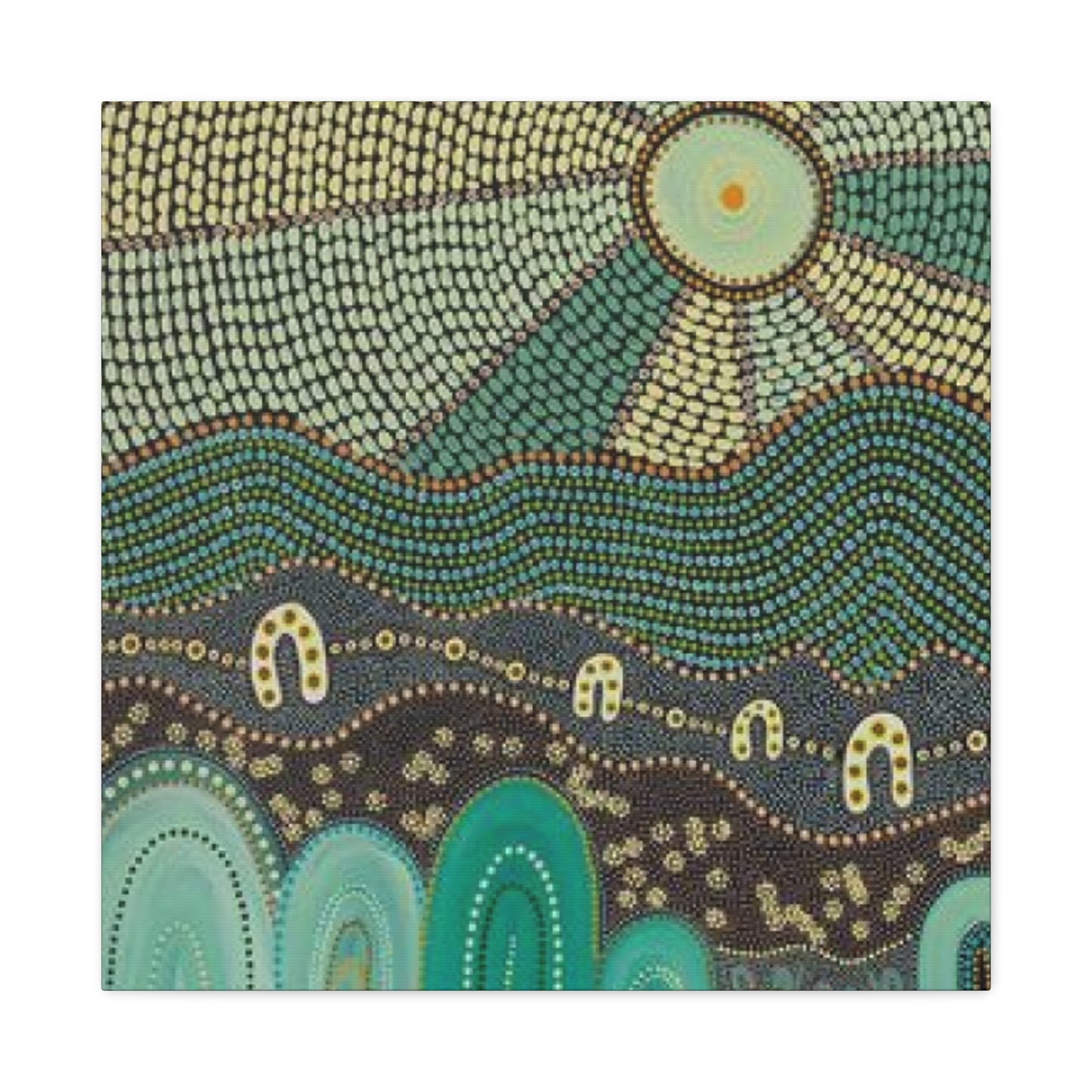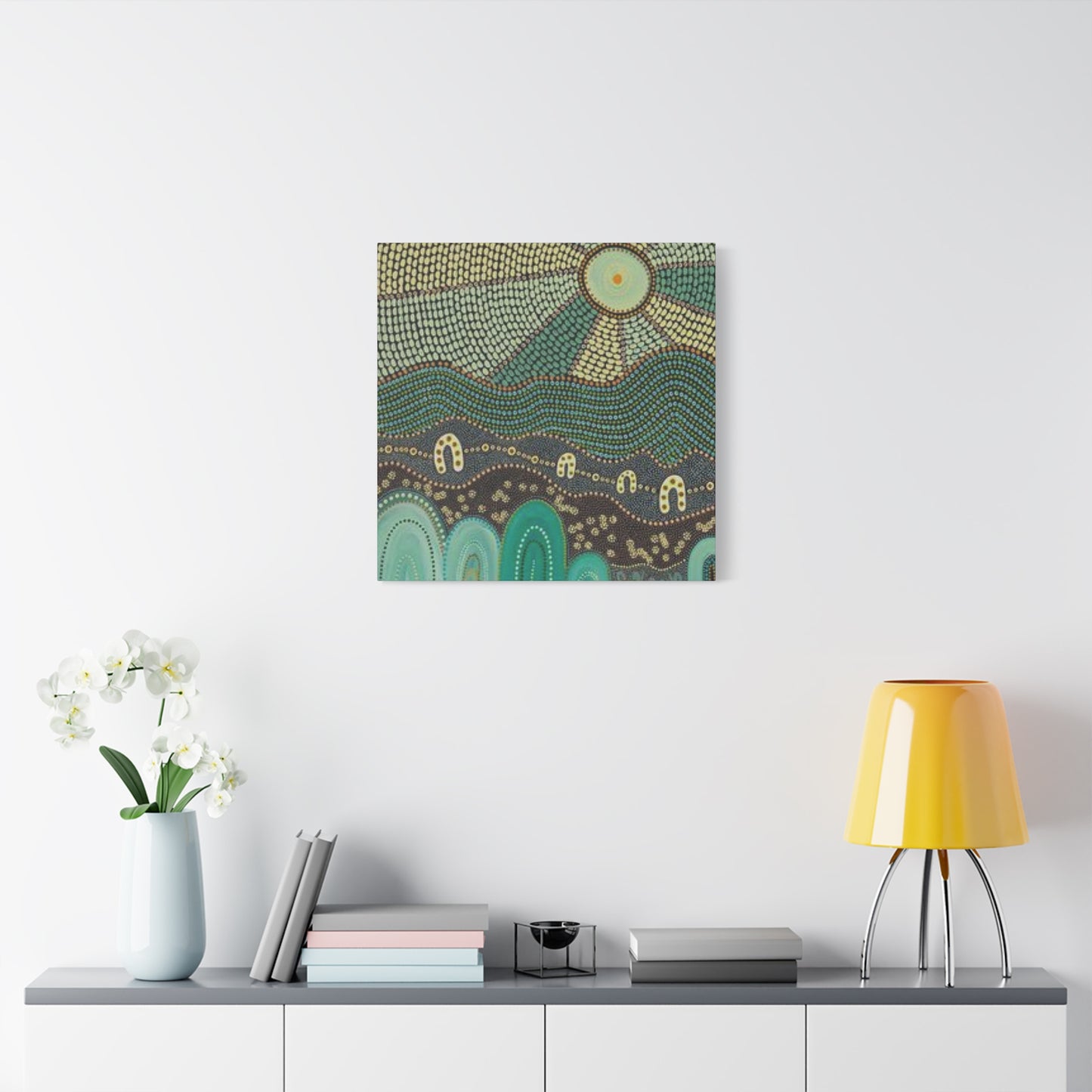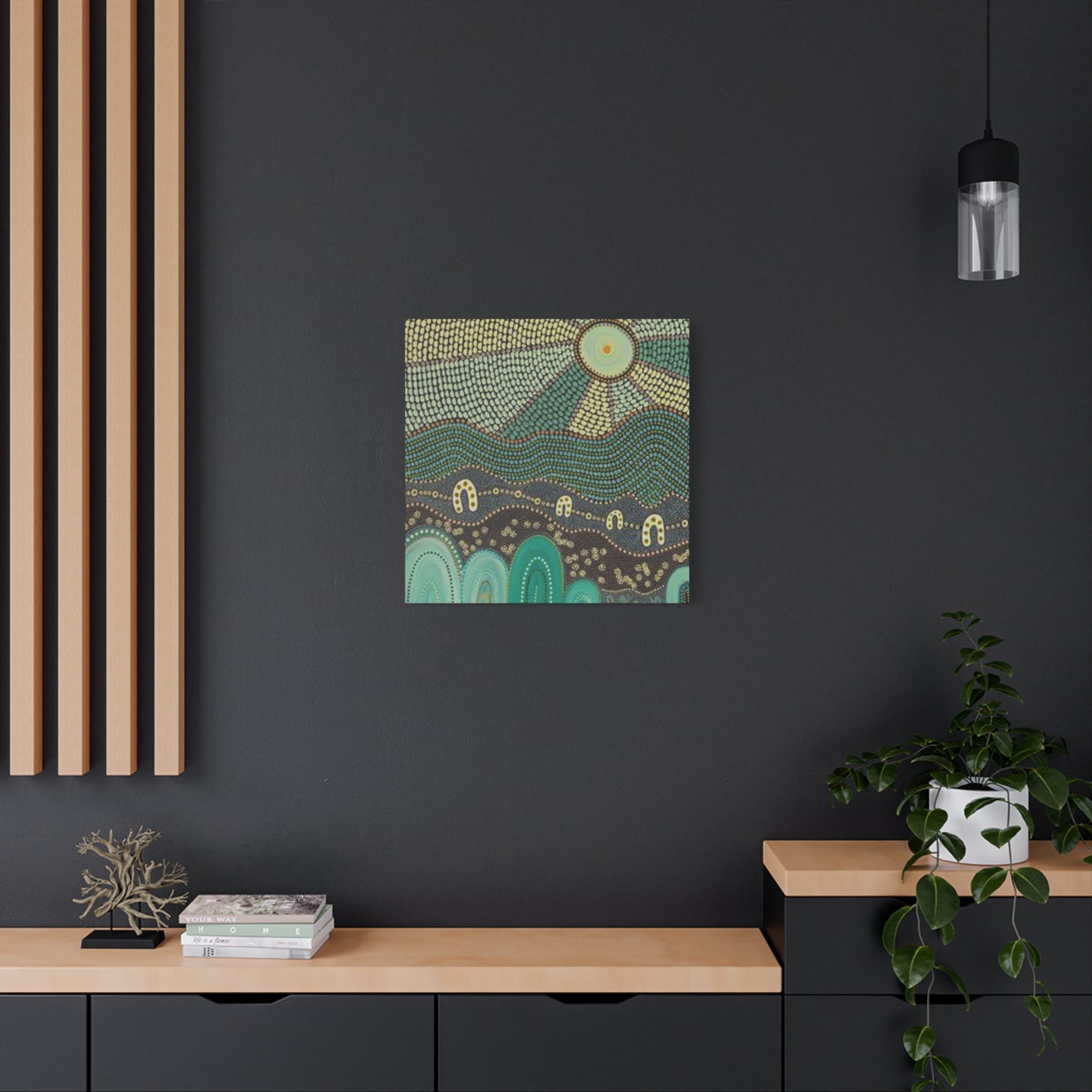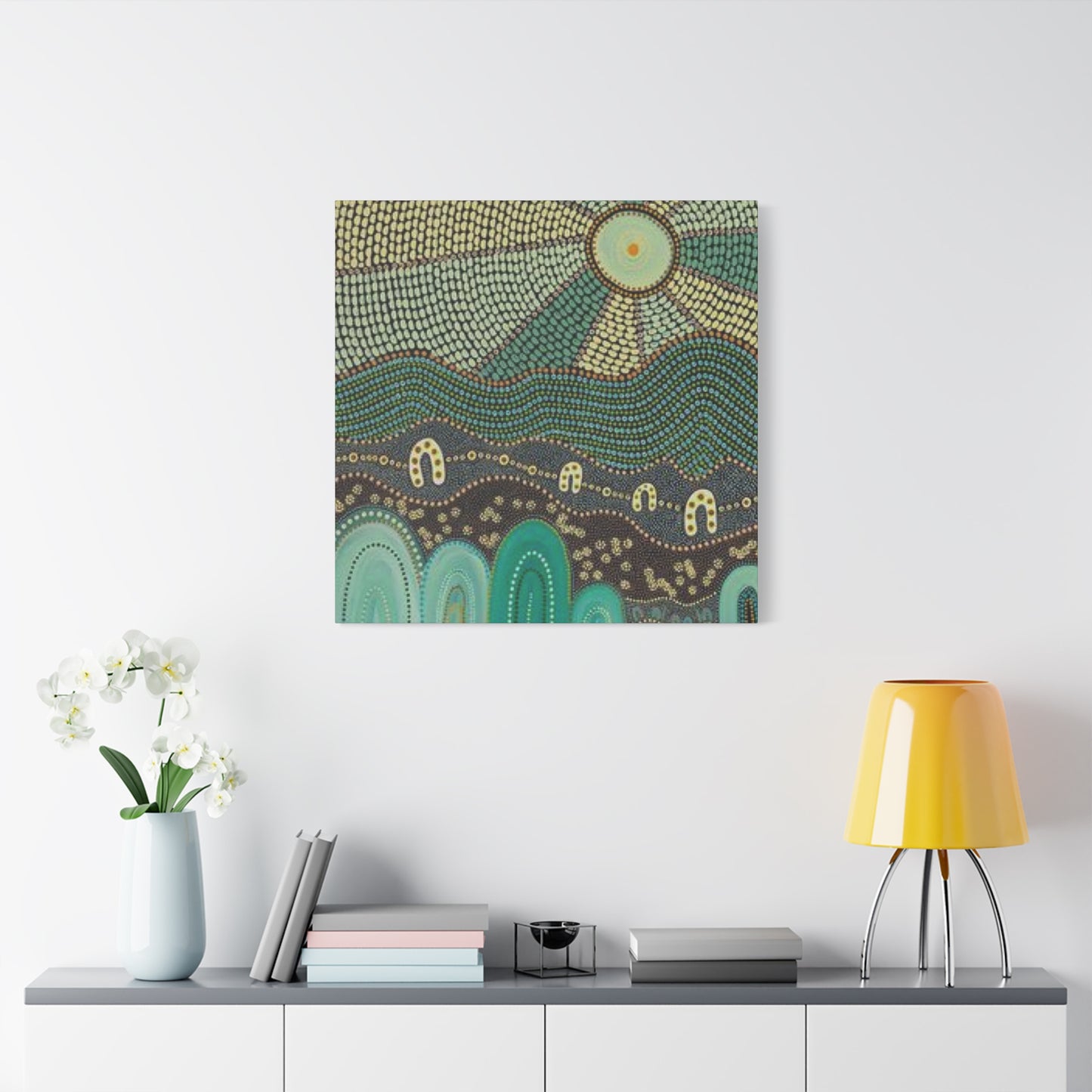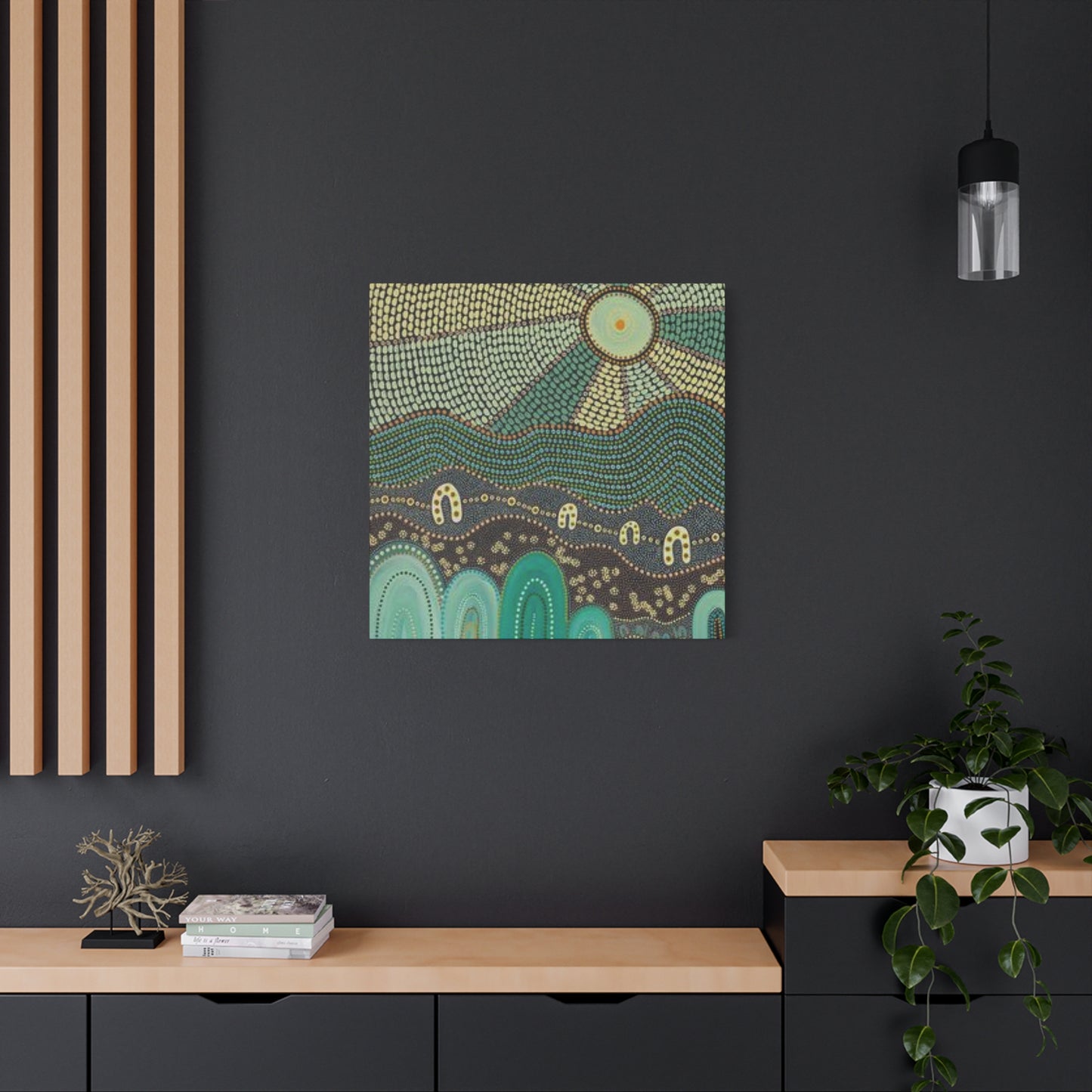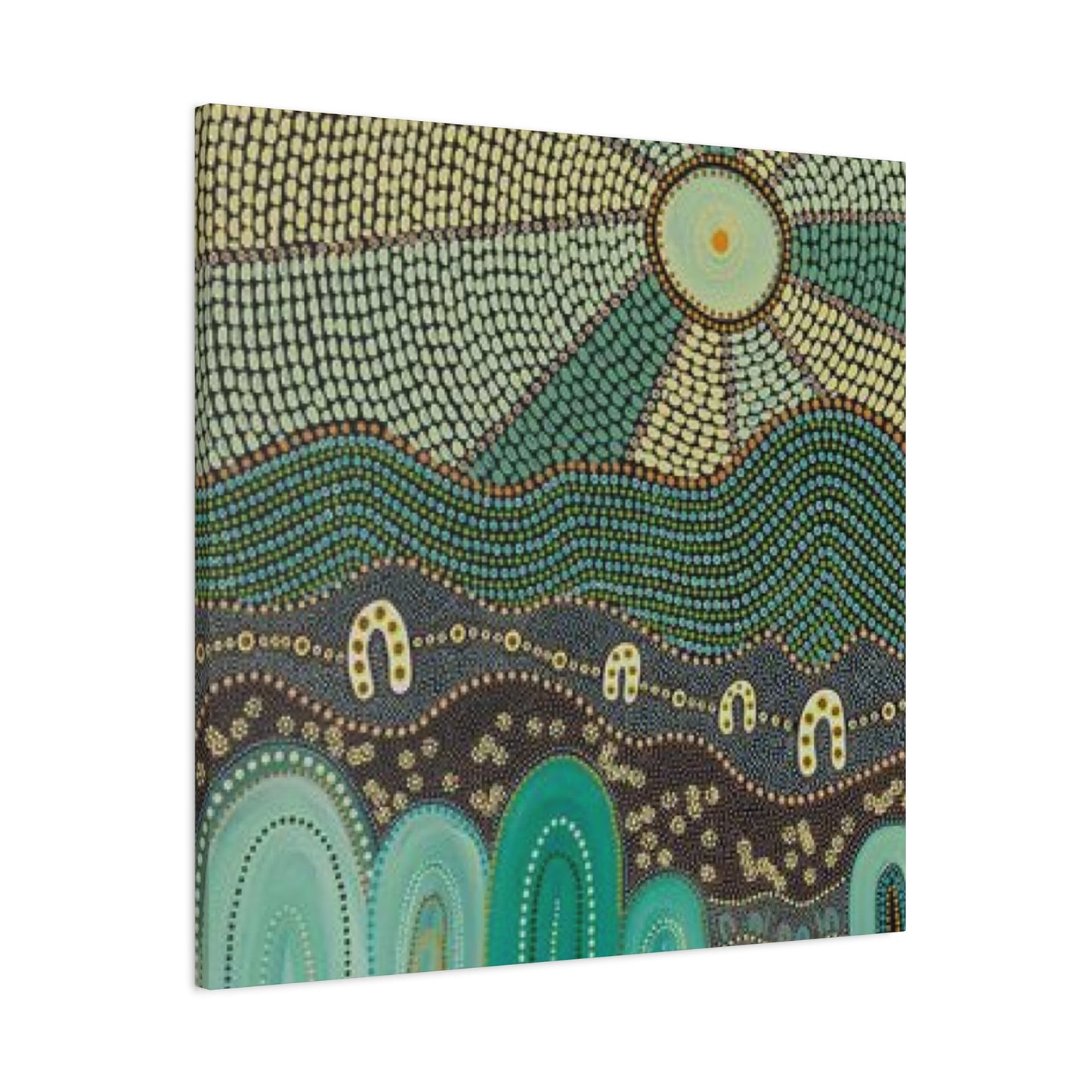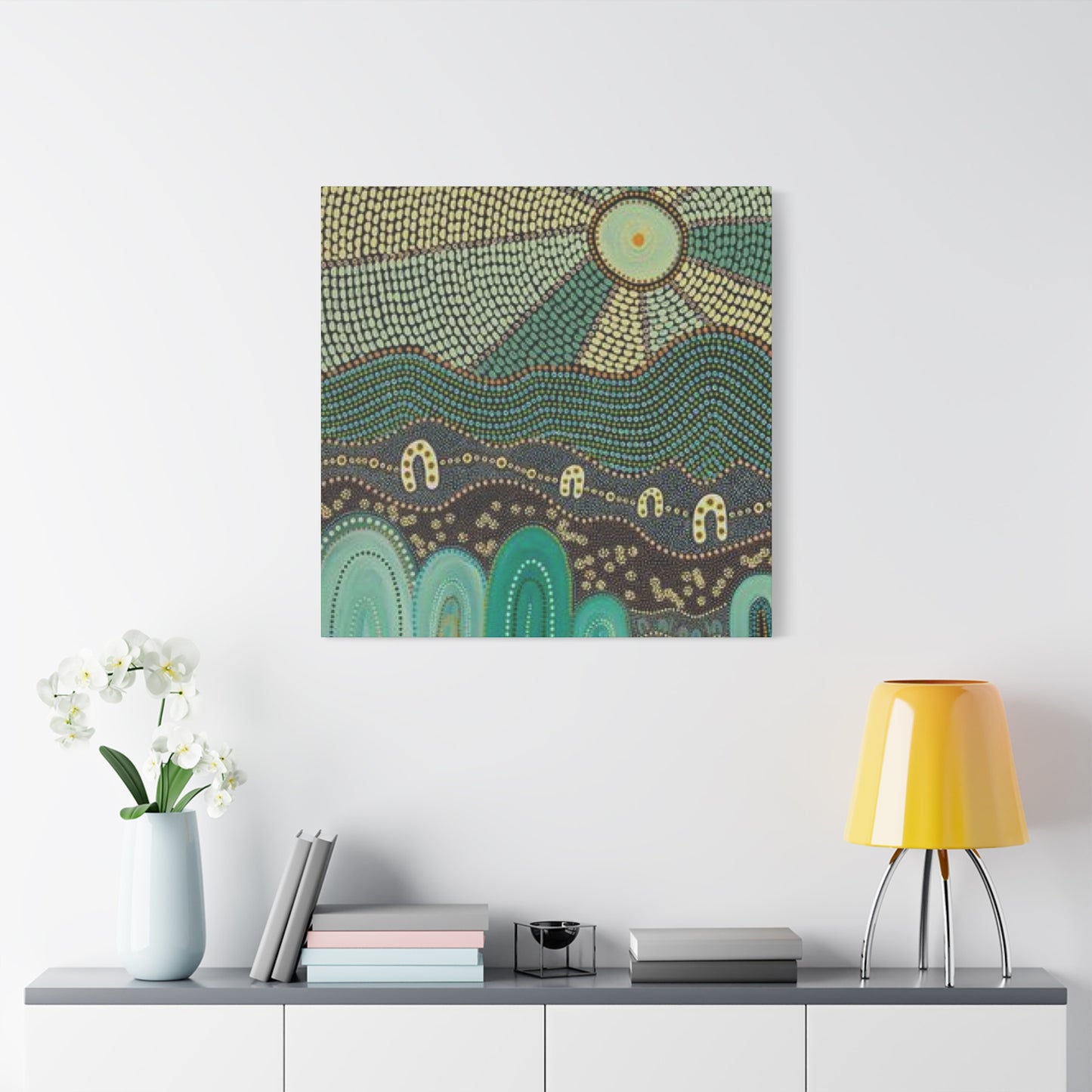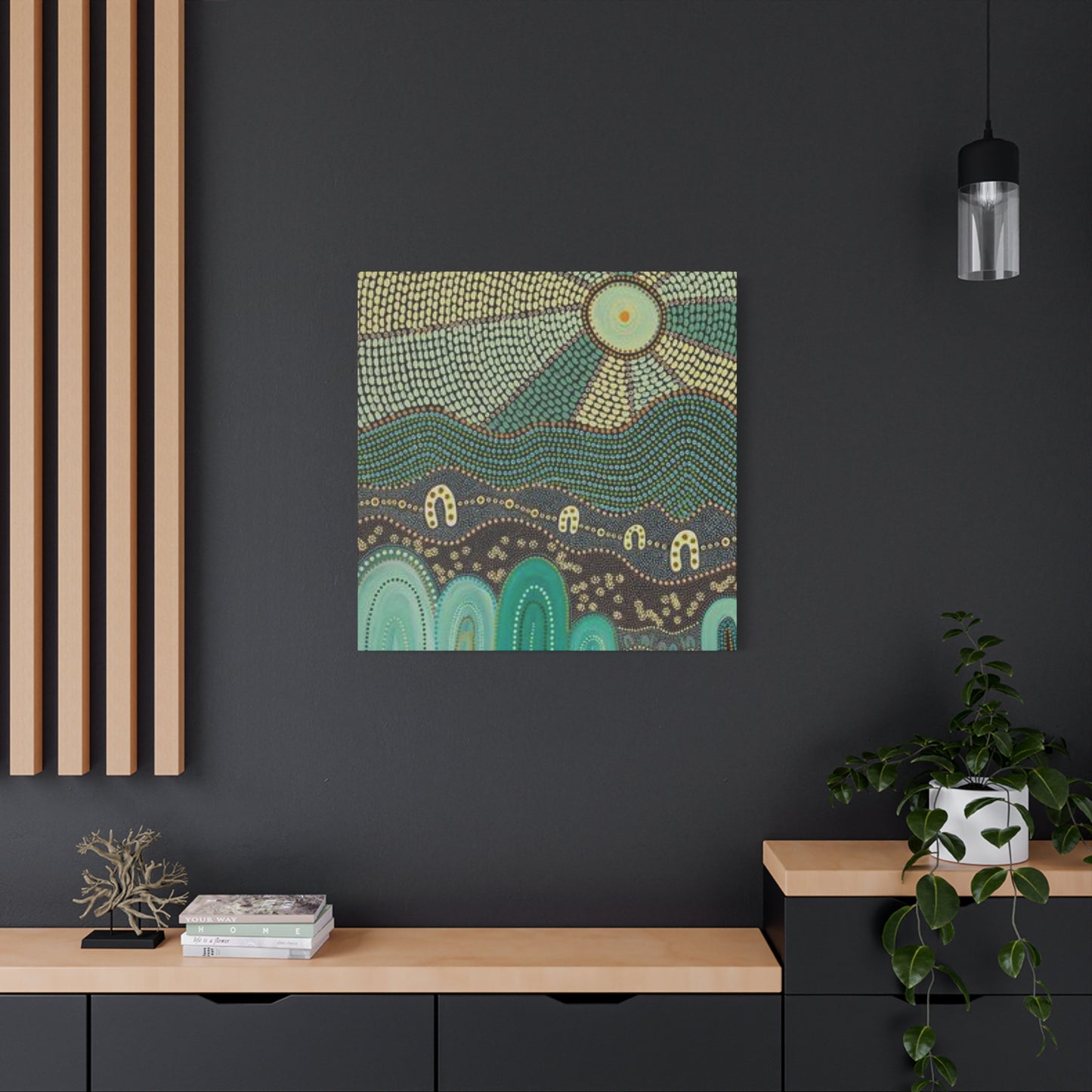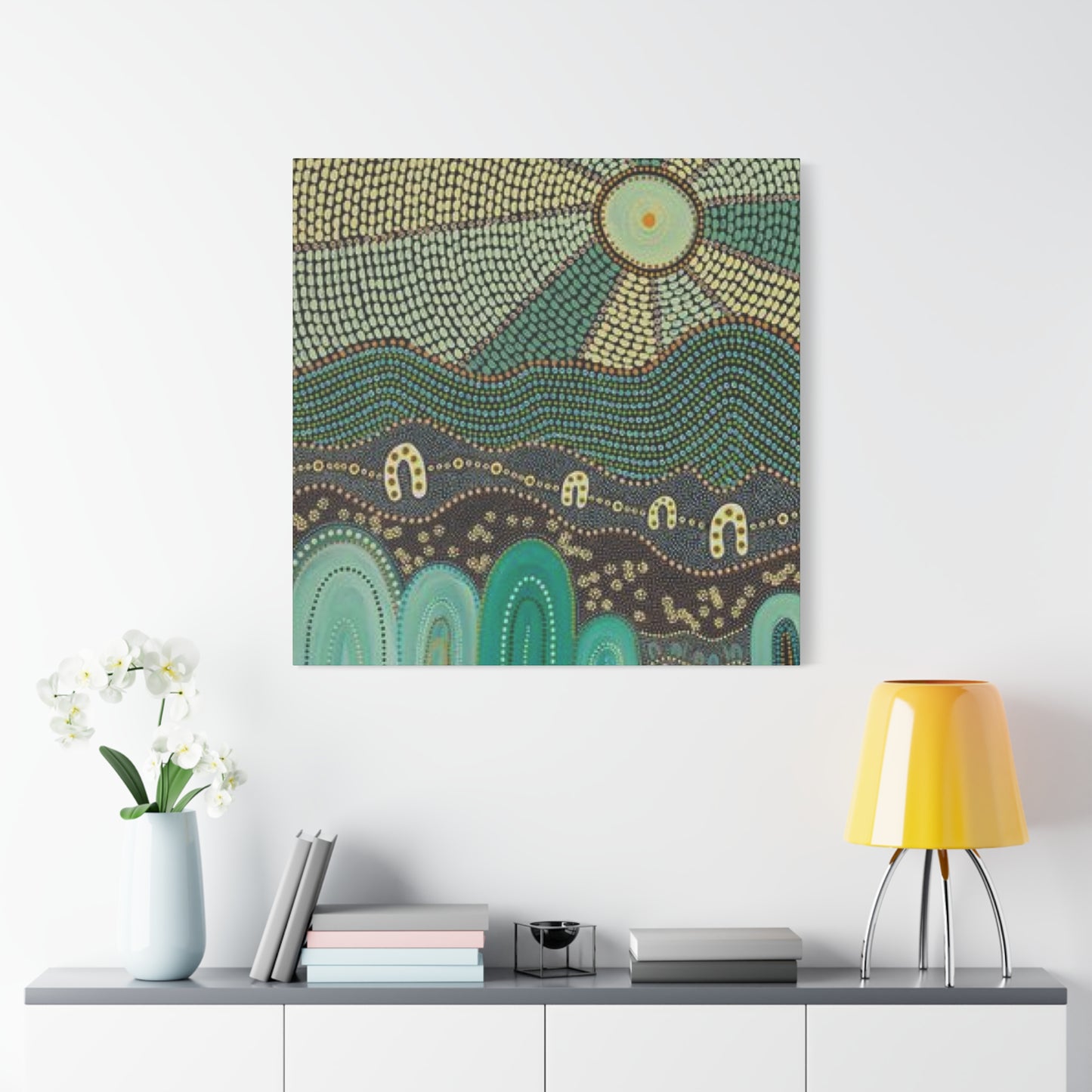Organic Geometry: The Elegance of Olive Green Pattern Drawing Wall Art
Olive green has emerged as one of the most sought-after colors in contemporary home decoration, offering a sophisticated blend of natural warmth and modern elegance. This earthy tone brings the tranquility of nature indoors, creating spaces that feel both grounded and refined. The color derives its name from the green olives found in Mediterranean regions, carrying with it associations of peace, harmony, and organic beauty.
Interior designers worldwide have embraced olive green for its remarkable versatility and ability to complement various design styles. Unlike brighter greens that can feel overwhelming or neon-like shades that appear artificial, olive green provides a muted, sophisticated presence that works beautifully in any room. This particular shade sits perfectly between yellow-green and gray-green on the color spectrum, making it neither too warm nor too cool.
The psychological impact of olive green in living spaces cannot be overstated. Research in color psychology suggests that this hue promotes feelings of balance, renewal, and connection to the natural world. When incorporated through wall art and canvas prints featuring intricate patterns and drawings, olive green becomes even more dynamic, adding layers of visual interest while maintaining its calming properties.
Homeowners appreciate how olive green patterns drawing wall art canvas prints can serve as statement pieces without dominating a space. The color has enough presence to anchor a room's design scheme while remaining subtle enough to allow other decorative elements to shine. This balance makes olive green an ideal choice for those seeking to create interiors that feel both intentional and effortlessly stylish.
The current trend toward biophilic design, which emphasizes bringing natural elements into built environments, has significantly boosted the popularity of olive green decor. This design philosophy recognizes the human need to connect with nature, even within urban settings. Olive green wall art serves as a visual reminder of forests, gardens, and outdoor landscapes, helping to satisfy this innate craving for natural connection.
Exploring Various Pattern Styles in Olive Green Wall Art
Pattern diversity in olive green canvas prints offers endless possibilities for personalization and style expression. Geometric patterns have gained tremendous traction in recent years, featuring clean lines, mathematical precision, and modern sensibility. These designs range from simple repeating shapes to complex tessellations that create mesmerizing optical effects. The combination of olive green with geometric precision produces artwork that feels both contemporary and timeless.
Botanical patterns represent another hugely popular category, showcasing everything from delicate fern fronds to bold tropical leaves. These nature-inspired designs work particularly well in olive green, as the color authentically represents foliage and plant life. Artists often incorporate multiple shades of olive, from lighter sage tones to deeper forest greens, creating depth and dimension within botanical compositions. Such patterns bring a sense of garden freshness to any interior space.
Abstract patterns in olive green offer maximum creative freedom, allowing artists to explore form, movement, and texture without representational constraints. These designs might feature flowing organic shapes, energetic brushstrokes, or layered compositions that reveal new details upon closer inspection. Abstract olive green wall art appeals to those who appreciate artistic expression and want their decor to spark conversation and contemplation.
Traditional patterns, including damask, paisley, and medallion designs, take on new life when rendered in olive green. These classic motifs, with their historical roots in textile design and architectural ornamentation, gain contemporary relevance through modern color application. The juxtaposition of traditional pattern with the currently trending olive green creates artwork that bridges past and present aesthetically.
Moroccan and Mediterranean patterns, featuring intricate tile-inspired designs and arabesque elements, pair exceptionally well with olive green. These patterns often incorporate repeating geometric forms combined with organic curves, creating visual rhythms that draw the eye across the canvas surface. The cultural richness embedded in these patterns adds layers of meaning and sophistication to any decorating scheme.
Minimalist patterns, characterized by sparse composition and maximum negative space, allow olive green to shine in its purest form. These designs might feature a single botanical element, a few strategic lines, or subtle textural variations. Minimalist olive green wall art suits contemporary and Scandinavian-inspired interiors where simplicity and restraint are valued aesthetic principles.
The Artistic Process Behind Creating Pattern Drawing Wall Art
Creating compelling pattern drawing wall art requires both technical skill and artistic vision. Artists typically begin with conceptual development, researching pattern traditions, studying natural forms, or exploring mathematical relationships that can inform design structures. This foundational phase involves sketching multiple iterations, experimenting with different motifs, and determining the overall composition strategy.
Line work forms the backbone of most pattern drawings, with artists using various techniques to achieve desired effects. Some employ precise technical pen work, creating crisp, uniform lines that emphasize pattern regularity and geometric precision. Others favor more expressive line qualities, using brush pens or markers to introduce variation in thickness and intensity. The choice of line work dramatically affects the final artwork's character and emotional impact.
Color application in olive green pattern art demands careful consideration of value, saturation, and harmony. Artists working digitally have infinite color adjustment possibilities, while those using traditional media must mix pigments to achieve the perfect olive green shade. Many pattern drawings incorporate multiple green tones, creating tonal variations that add visual interest and prevent monotony.
Texture addition elevates pattern drawings from flat designs to visually rich compositions. Artists might incorporate cross-hatching, stippling, or wash techniques to build textural elements. In digital work, layering effects, grain filters, and brush variations simulate traditional media textures. These textural components give olive green pattern art tactile appeal, even when viewed on smooth canvas surfaces.
The repetition and rhythm inherent in pattern work require careful planning to maintain consistency while avoiding mechanical rigidity. Skilled artists introduce subtle variations within repetitive elements, creating patterns that feel organic rather than machine-generated. This balance between order and variation keeps viewers engaged and prevents pattern fatigue.
Scale consideration plays a crucial role in pattern drawing effectiveness. Artists must determine whether their patterns will feature large, bold elements that make immediate impact or smaller, intricate details that reward closer examination. This decision affects how the artwork functions within different interior spaces and viewing distances.
Benefits of Choosing Canvas Prints for Olive Green Pattern Art
Canvas prints offer numerous advantages as a medium for displaying olive green pattern drawings, beginning with their professional gallery-quality appearance. The canvas texture adds subtle dimensionality to printed artwork, creating visual interest that flat paper prints cannot match. This texture interaction with printed patterns creates depth perception, making designs appear more sophisticated and finished.
Durability ranks among the top benefits of canvas prints, as properly produced canvases resist fading, warping, and damage far better than paper alternatives. High-quality canvas materials combined with fade-resistant inks ensure that olive green patterns maintain their color vibrancy for years. This longevity makes canvas prints a worthwhile investment for homeowners seeking lasting decorative solutions.
The frameless presentation typical of canvas prints contributes to their modern, clean aesthetic. Gallery-wrapped canvases, where the printed image continues around the sides, eliminate the need for traditional framing. This approach creates a contemporary floating effect when mounted on walls, allowing the artwork itself to take center stage without competing with frame ornamentation.
Lightweight construction makes canvas prints easy to hang and reposition without requiring professional installation services. Unlike heavy framed pieces that demand secure anchoring and multiple mounting points, canvas prints typically need only one or two hanging hardware pieces. This ease of installation empowers homeowners to experiment with different placements and arrangements without commitment anxiety.
Canvas prints accommodate various sizes more affordably than traditional framing options. Large-scale olive green pattern art that might prove prohibitively expensive when custom framed becomes accessible through canvas printing technology. This size flexibility allows for impactful statement pieces that transform entire walls into artistic focal points.
The slight texture and matte finish of canvas naturally reduce glare, improving viewability under various lighting conditions. Unlike glossy prints that create reflective spots and viewing angle limitations, canvas prints remain consistently visible from multiple positions. This practical benefit ensures that olive green pattern art displays beautifully regardless of room lighting configurations.
Emotional Impact of Olive Green
Olive green occupies a unique position in color psychology, bridging the calming properties of green with the grounding qualities of brown undertones. This combination creates a color that simultaneously energizes and soothes, making it ideal for spaces where balanced emotional states are desired. The color promotes feelings of stability, growth, and renewal without the stark intensity of brighter green shades.
Historical associations link olive green with peace, wisdom, and natural abundance. The olive branch has served as a peace symbol across cultures for millennia, lending olive green positive connotations that transcend cultural boundaries. These deep-rooted associations influence how people subconsciously respond to olive green in their living environments, creating atmospheres of tranquility and welcome.
In interior psychology, olive green functions as a sophisticated neutral that adds personality without overwhelming sensory input. Unlike true neutrals such as beige or gray that can feel sterile, olive green provides chromatic interest while maintaining versatility. This quality makes olive green pattern wall art suitable for individuals sensitive to color intensity who nonetheless desire visual warmth in their spaces.
The connection between olive green and nature triggers biophilic responses in human psychology. Exposure to natural colors, including various greens, has been linked to reduced stress levels, improved concentration, and enhanced mood states. Incorporating olive green patterns into home or office environments thus offers psychological benefits beyond pure aesthetic appeal.
Olive green's sophisticated appearance influences perceptions of taste and refinement. Interior spaces featuring this color often register as more mature and thoughtfully designed compared to those using primary colors or overly trendy shades. This perception makes olive green wall art appealing to individuals seeking to convey personal sophistication through their decorating choices.
Different olive green shades evoke varying emotional responses, with lighter variations feeling more optimistic and airy, while deeper tones create cozy, contemplative atmospheres. Pattern drawings in olive green can manipulate these emotional effects through color value choices, allowing artists to fine-tune the psychological impact of their work.
Selecting the Perfect Olive Green Wall Art for Different Rooms
Living room spaces benefit tremendously from larger olive green pattern canvas prints that serve as conversational focal points. These communal areas, where families gather and guests are entertained, deserve artwork that makes statements while maintaining welcoming atmospheres. Geometric or abstract patterns in olive green work particularly well in living rooms, adding visual interest without overwhelming the social nature of the space. Consider placing substantial canvas pieces above sofas or mantels where they anchor furniture arrangements and draw eyes upward.
Bedroom environments call for olive green wall art that promotes relaxation and restful sleep. Softer, more organic patterns such as botanical drawings or flowing abstract designs create calming visual experiences conducive to unwinding. The color's natural associations help prepare the mind for rest while adding personality to personal retreats. Positioning olive green pattern prints where they're visible from the bed creates positive visual anchors that bookend days with nature-connected imagery.
Dining areas present opportunities for more adventurous olive green pattern selections, as these spaces typically host shorter duration activities compared to living rooms or bedrooms. Bold geometric patterns or intricate traditional designs add sophistication to dining experiences, elevating everyday meals into more intentional occasions. The appetite-friendly nature of green tones makes olive particularly suitable for spaces associated with food and gathering.
Home office spaces greatly benefit from olive green's concentration-enhancing properties. Studies suggest that exposure to green tones improves focus and reduces eye strain, making olive green pattern wall art functional as well as decorative in work environments. Opt for patterns that provide visual interest during brief breaks without becoming distracting during focused work periods. Geometric or minimalist patterns typically strike this balance effectively.
Bathroom design increasingly incorporates meaningful artwork rather than generic prints, with olive green patterns offering spa-like sophistication. The color's connection to nature complements bathroom purposes of cleansing and renewal. Moisture-resistant canvas treatments ensure durability in these humid environments, while the color palette coordinates beautifully with natural materials like wood, stone, and ceramic.
Entryway and hallway spaces often suffer from decorating neglect despite being high-traffic areas that shape first impressions. Olive green pattern canvas prints transform these transitional spaces into intentional design moments. Series of smaller coordinating prints create gallery wall effects in narrow hallways, while single statement pieces anchor entry areas, immediately establishing home aesthetic tones.
Complementary Color Schemes for Olive Green Pattern Art
Neutral color palettes provide the most versatile backdrop for olive green pattern wall art, allowing the artwork to shine without color competition. Whites, creams, and beiges create clean contrasts that highlight olive green's richness while maintaining bright, airy room feelings. This combination works particularly well in contemporary and minimalist interiors where simplicity and restraint guide design decisions. The contrast between neutral walls and olive green art creates visual hierarchy that draws attention to the artwork naturally.
Warm earth tone combinations, including terracotta, rust, and ochre, create rich, enveloping color schemes when paired with olive green. These palettes evoke Southwestern, Mediterranean, or bohemian aesthetics, depending on pattern choices and accessory selections. The shared warmth across these colors creates cohesive, welcoming environments that feel organic and intentionally composed. This approach suits those seeking cozy, lived-in aesthetics with strong personality.
Cool gray pairings offer sophisticated, modern alternatives to traditional neutral combinations. The temperature contrast between warm olive green and cool gray creates dynamic tension that keeps interiors visually interesting. This combination works beautifully in urban settings and contemporary spaces where sleek sophistication is desired. Varying gray values from light to charcoal provides tonal depth while maintaining color restraint.
Navy blue and olive green create unexpectedly harmonious partnerships, with both colors sharing similar value levels and natural associations. This combination reads as both bold and refined, suitable for masculine-leaning or traditionally styled interiors. The depth of both colors creates moody, intimate atmospheres perfect for libraries, studies, or cozy living areas. Metallic accents in brass or gold add warmth to this otherwise cool-dominant palette.
Blush pink and olive green pairings have gained significant popularity in recent design trends, offering a fresh take on feminine color schemes. The softness of blush tempers olive green's earthiness, creating balanced palettes that feel both current and timeless. This combination works particularly well in bedrooms, nurseries, or spaces seeking romantic, approachable aesthetics. The contrast between warm pink and cooler olive creates visual interest while maintaining overall softness.
Monochromatic green schemes, using various shades from sage to forest green, create immersive, nature-inspired environments. Olive green pattern art fits beautifully within these schemes, providing tonal variation while maintaining color family cohesion. This approach suits maximalist or bohemian interiors where layering and abundance are celebrated rather than restrained.
The Role of Pattern Scale in Wall Art Impact
Large-scale patterns in olive green wall art create immediate, dramatic impact suitable for spacious rooms and high-ceiling environments. These bold designs feature oversized motifs that can be appreciated from distance, making them ideal for open-concept living areas or commercial spaces. The visual weight of large patterns helps anchor furniture groupings and define zones within larger rooms. However, these designs require adequate wall space to be fully appreciated without feeling cramped or overwhelming.
Medium-scale patterns offer the most versatility, working effectively in various room sizes and design contexts. These balanced designs feature motifs sized appropriately for typical residential wall spaces, typically readable from normal conversational distances. Medium patterns provide visual interest without dominating attention, making them suitable for rooms where the artwork should enhance rather than overpower other design elements. This scale category encompasses the broadest range of pattern types and styles.
Small-scale patterns, featuring intricate details and compact repeating elements, reward close viewing and create textural effects from distance. These designs work particularly well in intimate spaces like powder rooms, reading nooks, or alongside beds where viewers naturally spend time in close proximity. The complexity of small-scale patterns provides ongoing visual discovery, revealing new details upon repeated viewing. These designs photograph beautifully and often appear more sophisticated than their bolder counterparts.
Variable-scale patterns, incorporating elements of different sizes within single compositions, create dynamic visual experiences. These designs guide eye movement across the canvas surface, preventing static viewing experiences. The scale variation adds depth perception and compositional complexity that elevates pattern work beyond simple repetition. Such patterns work well in spaces viewed from multiple distances, as they offer different experiences depending on viewer position.
The relationship between pattern scale and room dimensions requires careful consideration during selection. Oversized patterns in small rooms can feel claustrophobic, while tiny patterns in vast spaces may disappear visually. A useful guideline suggests that pattern motifs should be roughly proportional to wall dimensions, though intentional violations of this rule can create striking effects when executed thoughtfully.
Viewing distance significantly impacts pattern scale effectiveness. Artwork positioned in hallways or across from seating areas benefits from larger-scale patterns that remain clear from distance. Conversely, art placed near desks, bedside tables, or in intimate spaces can feature more intricate, smaller-scale patterns that invite closer examination.
Mixing and Matching Olive Green Patterns with Other Decor
Textile coordination with olive green pattern wall art creates cohesive, intentionally designed interiors. Throw pillows, blankets, and upholstery fabrics can echo colors from the artwork while introducing complementary patterns at different scales. Mixing pattern scales prevents visual competition, allowing each element to contribute to overall design harmony. For instance, large-scale olive green botanical wall art pairs beautifully with smaller-scale geometric pillow patterns in coordinating colors.
Furniture selection significantly impacts how olive green wall art integrates into spaces. Natural wood tones, particularly warmer varieties like oak, walnut, and teak, complement olive green beautifully through shared earthiness. These organic materials create cohesive nature-inspired aesthetics when combined with botanical or abstract organic patterns. Conversely, sleek modern furniture in white, black, or metal finishes creates striking contrast that emphasizes both furniture and artwork through juxtaposition.
Lighting design plays a crucial role in maximizing olive green pattern art impact. Directional spotlights or picture lights add drama by creating shadows and highlights that emphasize pattern dimensionality. Ambient lighting affects color perception, with warm bulbs enriching olive green's golden undertones while cool lighting emphasizes its gray-green qualities. Layered lighting schemes that include multiple source types provide flexibility to adjust room atmosphere while maintaining artwork visibility.
Accessory curation allows for personality expression while reinforcing color schemes established by olive green wall art. Vases, sculptures, books, and decorative objects in coordinating or contrasting colors build visual connections across room elements. Metallic accessories in brass, bronze, or gold add warmth and glamour to olive green schemes, while silver and chrome create cooler, more contemporary effects. Plant life, whether real or artificial, creates obvious connections with nature-inspired olive green pattern art.
Flooring consideration affects overall color balance in rooms featuring olive green wall art. Light wood, bamboo, or pale tile floors brighten spaces while providing neutral foundations that allow wall art to dominate visually. Darker flooring creates moodier, more intimate environments where olive green patterns contribute to overall enveloping effects rather than standing out as focal points. Area rugs offer opportunities to introduce additional patterns and colors that bridge flooring and wall art.
Window treatment coordination completes the layered approach to integrating olive green pattern art. Curtains or blinds can pick up accent colors from the artwork, creating visual flow around room perimeters. Sheer treatments maintain brightness while adding subtle color reinforcement, whereas heavier drapes in complementary solids or coordinating patterns contribute to cozy, finished aesthetics.
Understanding Different Canvas Printing Techniques and Quality
Giclée printing represents the gold standard in canvas reproduction technology, using archival-quality inks and high-resolution digital files to produce museum-quality results. This process employs specialized inkjet printers that apply multiple ink colors in microscopic dots, creating smooth color gradations and exceptional detail retention. Giclée prints of olive green pattern art maintain color accuracy and tonal subtlety far superior to standard printing methods, justifying premium pricing through longevity and quality.
UV-resistant inks ensure that olive green canvas prints maintain color vibrancy despite exposure to natural and artificial light. Standard inks fade noticeably within months when subjected to sunlight, while UV-resistant formulations resist degradation for decades. This protection is particularly crucial for olive green, as shifting toward brown or yellow tones would significantly alter artwork appearance and design scheme compatibility.
Canvas material quality varies considerably, affecting both appearance and durability. Premium cotton canvas provides superior texture, color absorption, and structural stability compared to synthetic alternatives. The weave density impacts print sharpness, with tighter weaves yielding crisper detail rendering. Artist-grade canvas materials resist sagging and environmental damage, maintaining taut gallery-wrapped appearance for years without professional re-stretching.
Stretcher bar construction determines canvas print structural integrity and professional appearance. Kiln-dried solid wood bars resist warping and provide necessary rigidity, while cheaper alternatives using composite materials may bow or twist over time. Corner joining methods affect stability, with mortise-and-tenon joints outlasting simple stapled connections. Adequate bar depth, typically ranging from three-quarters of an inch to two inches, provides the gallery-wrapped floating effect and prevents canvas contact with walls.
Coating application protects olive green canvas prints from environmental damage while affecting visual appearance. Satin coatings provide subtle sheen that enriches colors without creating glare, representing the most popular finish choice. Matte coatings eliminate shine entirely, creating flat appearances that emphasize pattern design over surface characteristics. Gloss coatings intensify colors but create viewing angle limitations through reflection.
Resolution requirements for quality canvas printing demand high-quality source files, typically 300 DPI or greater at final print dimensions. Insufficient resolution results in visible pixelation or blurriness that undermines pattern clarity and professional appearance. Reputable canvas print providers specify minimum file requirements and may refuse orders that cannot meet quality standards, protecting both their reputation and customer satisfaction.
Creating Gallery Wall Arrangements with Olive Green Pattern Art
Symmetrical gallery wall layouts create formal, balanced presentations suitable for traditional or transitional interiors. These arrangements typically feature identical or similarly sized olive green pattern canvases arranged in grid formations. The order and regularity of symmetrical layouts convey intentionality and careful planning, making spaces feel more refined and pulled together. This approach works particularly well flanking architectural features like fireplaces or doorways where balanced visual weight feels appropriate.
Asymmetrical gallery walls offer more contemporary, casual aesthetics through varied canvas sizes and irregular spacing. These arrangements feel organic and collected-over-time rather than purchased as sets, adding personality and lived-in charm. Creating successful asymmetrical layouts requires attention to visual weight distribution, ensuring that larger or darker olive green pieces balance smaller or lighter elements across the overall composition. Mock layouts on the floor before hanging help prevent multiple wall holes from repositioning.
Color coordination across gallery wall elements creates cohesive visual experiences. Olive green pattern art can anchor multi-color galleries where other pieces introduce complementary hues, or dominate single-color schemes for dramatic impact. Repeating specific olive green shades across multiple pieces strengthens visual connections, while varying shades adds tonal interest and prevents monotony.
Frame consistency, even when using gallery-wrapped canvases without traditional frames, contributes to polished gallery wall appearance. Maintaining consistent canvas depths creates uniform floating effects, while varied depths add dimensionality but require careful arrangement to avoid haphazard appearance. When mixing framed and frameless pieces, consistent frame finishes or coordinating colors prevent visual chaos.
Spacing calculations significantly impact gallery wall success, with consistent gaps between pieces creating professional, intentional appearance. Standard spacing ranges from two to four inches, though intimate galleries may use narrower gaps while statement galleries employ wider separation. Template usage, either purchased or created from craft paper, allows precise preplanning and single-attempt hanging success.
Focal point establishment provides anchor points that organize gallery wall viewing experiences. Larger olive green pattern canvases naturally draw attention and can serve as compositional centers around which smaller pieces orbit. Alternatively, positioning the most visually complex or colorful piece at eye level creates natural starting points for visual exploration.
Seasonal Decorating with Olive Green Pattern Wall Art
Spring incorporation of olive green pattern art emphasizes the color's connection to new growth and renewal. Lighter olive shades and botanical patterns feel particularly appropriate as nature awakens from winter dormancy. Pairing olive green wall art with fresh flowers, pastel accents, and lightweight textiles creates cheerful, optimistic environments that celebrate seasonal transition. The color's association with budding plants and sprouting leaves makes it a natural spring palette component.
Summer design benefits from olive green's cooling properties and natural associations. While warm weather often inspires brighter color schemes, olive green provides sophisticated alternatives to predictable summer palettes. Pairing olive pattern art with crisp whites, natural fibers, and abundant greenery creates resort-like atmospheres within homes. The color works particularly well in outdoor living spaces or sunrooms where indoor-outdoor connections are emphasized.
Autumn represents olive green's peak season, as the color perfectly captures fall's earthy, harvest-inspired aesthetics. The warmth in olive green complements seasonal colors like burnt orange, golden yellow, and rusty red without competing for attention. Layering olive green pattern art with autumn accessories like dried grasses, pumpkins, and cozy textiles creates welcoming spaces perfect for cooler weather gathering. The color's association with olive harvests adds subtle thematic appropriateness to fall decorating.
Winter decorating incorporates olive green as a sophisticated alternative to traditional holiday colors. While red and green dominate December, olive green offers year-round versatility that transitions seamlessly beyond holiday seasons. The color pairs beautifully with winter whites, deep burgundies, and metallic golds, creating elegant seasonal schemes. Olive green pattern art provides permanent fixtures around which seasonal accessories rotate, maintaining design continuity while allowing decorative refreshment.
Transitional decorating between seasons leverages olive green's year-round appropriateness and versatility. Unlike seasonal colors that demand removal after specific periods, olive green pattern wall art functions as permanent foundational elements. Accessory swapping around constant olive green artwork creates seasonal variation without requiring major design overhauls. This approach proves both economically and environmentally sustainable compared to seasonal complete redesigns.
Holiday-specific decorating incorporates olive green pattern art as neutral backdrops that complement rather than compete with festive accessories. The color's subtlety allows holiday decorations to shine while providing more sophisticated foundations than stark white walls. Olive green's compatibility with natural materials like evergreen branches, pinecones, and wood elements makes it particularly suitable for organic, nature-inspired holiday decorating approaches.
Sourcing High-Quality Olive Green Pattern Canvas Prints
Online marketplaces offer vast selections of olive green pattern canvas prints at various price points and quality levels. These platforms connect consumers with independent artists, print-on-demand services, and established art retailers, providing unprecedented choice and convenience. However, quality varies significantly across sellers, requiring careful evaluation of reviews, return policies, and product specifications before purchasing. Reputable marketplaces typically feature customer photos and detailed seller ratings that provide insight into actual product quality beyond staged promotional images.
Independent artist platforms allow direct purchases from creators, often yielding unique olive green pattern designs unavailable through mass-market retailers. These sources support working artists while providing exclusive artwork that enhances home uniqueness. Many artists offer customization options regarding size, color adjustments, or even commissioned original patterns tailored to specific needs. Building relationships with favored artists can yield personalized service and early access to new collections.
Home decor retailers, both physical stores and online operations, curate olive green pattern art selections that align with current trends and established style categories. These sources provide convenience and often feature coordinated collections where multiple pieces work together seamlessly. While potentially offering less uniqueness than independent artist sources, reputable retailers ensure consistent quality standards and straightforward return processes if artwork proves unsatisfactory.
Custom printing services transform personal designs or licensed artwork into canvas prints, offering ultimate personalization for those with specific visions. These services require providing high-resolution image files but deliver exactly specified results regarding size, material, and finishing. Quality varies significantly across providers, making sample ordering or thorough research essential before committing to expensive large-format pieces.
Art galleries and local artists provide opportunities for original olive green pattern artwork rather than reproductions. While significantly more expensive than canvas prints, original art carries unique value through one-of-a-kind status and direct artist connection. Supporting local art communities contributes to cultural vitality while ensuring completely unique home decoration.
Craft fairs and art festivals showcase emerging artists and unique olive green pattern designs in person, allowing quality assessment before purchase. These venues often yield unexpected discoveries and bargain pricing compared to gallery representation. The temporary nature of such events means selection varies constantly, rewarding regular attendance with fresh options.
DIY Approaches to Creating Olive Green Pattern Art
Hand-painting olive green patterns directly onto canvas allows complete creative control and guaranteed uniqueness. This approach requires artistic confidence and technical skills but yields one-of-a-kind results impossible through reproduction methods. Acrylic paints work particularly well for pattern creation through quick drying times and easy layering capabilities. Mixing custom olive green shades ensures perfect color matching with existing decor while adding subtle variations that enhance visual interest.
Stenciling techniques simplify pattern creation for those lacking freehand drawing confidence. Pre-cut stencils in geometric, botanical, or traditional patterns enable crisp, professional-looking results with minimal artistic training. Layering multiple stencils in varying olive green shades builds complexity and depth within compositions. This method works well for creating coordinated multi-piece sets where pattern consistency across canvases is desired.
Block printing offers another accessible technique for creating olive green pattern canvas art. Carved rubber or linoleum blocks transfer repeated motifs through paint application and pressing, building patterns through accumulation. This method naturally introduces slight variations that add handmade charm while maintaining overall pattern consistency. The physicality of block printing creates satisfying creative processes with relatively low technical barriers to entry.
Digital design tools democratize pattern creation, allowing precise control over every element. Software ranging from professional-grade applications to beginner-friendly programs enables pattern development through drawing, arranging, and coloring virtual elements. Finished digital designs can be printed through professional canvas printing services or home large-format printers for those with equipment access. This approach combines creative satisfaction of original design with professional-quality finished products.
Collage techniques create textured olive green pattern artwork through layering papers, fabrics, or found materials. This additive process builds visual interest through material variety and dimensional relief. Transparent mediums like gel medium adhere elements while allowing colors to interact optionally. Collage approaches suit those who enjoy tactile, experimental creative processes and appreciate artwork with physical texture beyond flat surfaces.
Mixed media approaches combine multiple techniques within single pieces, perhaps pairing painted backgrounds with stenciled foregrounds and collage accents. This layered methodology creates rich, complex artwork that rewards close examination. The freedom to improvise and adjust throughout creation processes suits intuitive artists who prefer discovery-based making rather than predetermined outcomes.
Maintaining Canvas Print Artwork
Dust accumulation represents the primary ongoing maintenance concern for olive green canvas prints. Regular gentle dusting with soft, dry cloths or feather dusters prevents buildup that dulls colors and embeds in canvas texture. Avoiding compressed air cans prevents propellant residue deposits, while vacuum cleaners with soft brush attachments work well for larger pieces. Weekly or biweekly dusting during general housecleaning suffices for most environments, though high-traffic or dusty locations may require more frequent attention.
Sunlight protection extends olive green canvas print lifespan significantly by preventing premature fading. Direct sunlight exposure, particularly intense afternoon sun, accelerates color degradation even in UV-resistant prints. Positioning artwork away from windows or using UV-filtering window films protects investments while maintaining natural light benefits. Rotating artwork between high and low light exposure locations can equalize aging across collections.
Humidity control prevents canvas material degradation and mold growth, particularly important in bathrooms, basements, or humid climates. Excessive moisture causes canvas sagging, wooden stretcher warping, and potential mildew development. Maintaining relative humidity between 40-60 percent through dehumidifiers or climate control protects artwork while providing comfortable living conditions. Adequate ventilation in moisture-prone rooms proves essential for long-term canvas preservation.
Temperature stability prevents expansion and contraction cycles that stress canvas material and stretcher frames. Avoiding placement near heating vents, fireplaces, or cooling units extends artwork lifespan by preventing material fatigue from repeated environmental fluctuations. Consistent moderate temperatures characteristic of climate-controlled living spaces provide ideal conditions for canvas longevity.
Cleaning beyond routine dusting occasionally becomes necessary when artwork accumulates grime or accidental spills occur. Gentle approaches using barely damp cloths with mild soap solution work for most situations, though testing on inconspicuous areas first prevents widespread damage. Avoiding saturation and immediate drying after cleaning prevents moisture penetration into canvas backing and stretcher components. Professional cleaning services handle serious soiling or valuable pieces where risk mitigation justifies expense.
Professional preservation services offer protective coatings that enhance canvas print durability and cleanability. These treatments, applied post-purchase or sometimes included in premium prints, create barriers against environmental damage while simplifying maintenance. Costs vary based on canvas size and coating type, but investment often proves worthwhile for particularly valued pieces or challenging display environments.
Applications of Olive Green Pattern Art
Office environments benefit significantly from olive green pattern wall art through improved aesthetics and employee wellbeing. The color's concentration-enhancing properties and stress-reducing effects contribute to productive, pleasant workspaces. Large-scale olive green pattern installations in reception areas, conference rooms, and common spaces establish professional sophistication while humanizing corporate environments. Pattern choices reflecting company values or industry connections add meaningful symbolic dimensions beyond pure decoration.
Hospitality venues including hotels, restaurants, and cafes use olive green pattern art to create memorable, Instagram-worthy spaces that encourage social sharing and repeat visits. The color's current trendiness appeals to style-conscious clientele while its timeless qualities prevent rapid obsolescence. Coordinating olive green artwork with overall interior design schemes creates cohesive brand experiences that differentiate establishments in competitive markets.
Retail environments employ olive green pattern canvas prints to establish brand identities and enhance customer experiences. Boutiques, particularly those selling natural products, organic goods, or sustainable fashion, find olive green particularly brand-appropriate. The color's sophistication elevates perceived product value while its warmth creates welcoming shopping environments that encourage browsing and extended visits.
Healthcare facilities increasingly recognize the therapeutic value of nature-connected design elements including olive green pattern artwork. The color's calming properties help reduce patient anxiety in waiting rooms, examination rooms, and recovery spaces. Biophilic design principles incorporating natural colors and patterns have demonstrated measurable health outcome improvements, making olive green art investments with quantifiable returns beyond aesthetic enhancement.
Educational institutions from preschools through universities benefit from olive green's focus-supporting properties and versatile aesthetic appeal. Pattern art adds visual interest to institutional spaces while avoiding overstimulation that interferes with learning activities. The color's age-appropriate appeal across developmental stages makes it practical for institutions serving diverse populations.
Event spaces and wedding venues incorporate olive green pattern artwork into their permanent decor to provide attractive backdrops for various occasions. The color's photography-friendly qualities and trend-current status make it desirable for clients documenting celebrations. Neutral enough to accommodate diverse event themes while distinctive enough to add character, olive green proves highly functional in multi-use venues.
Benefits of Pattern Recognition in Art
Pattern recognition engages fundamental cognitive processes that humans find inherently satisfying. The brain constantly seeks patterns as survival mechanisms, finding order in chaos and predicting future events based on recognized sequences. Olive green pattern artwork taps into these deep neurological responses, providing mental engagement that feels pleasant rather than taxing. This engagement offers mild stimulation that enlivens spaces without creating distraction or mental fatigue.
Repetitive visual elements in pattern art create rhythm that guides eye movement and provides viewing structure. This visual rhythm generates aesthetic pleasure similar to musical rhythm, engaging viewers through predictable variation. The balance between expectation and surprise in well-designed patterns maintains interest through multiple viewings, preventing the boredom that completely predictable designs might generate.Meditative qualities emerge from viewing complex patterns, particularly those incorporating natural forms or mathematical precision.
Conclusion
Organic Geometry: The Elegance of Olive Green Pattern Drawing Wall Art beautifully encapsulates the harmony between structured design and natural inspiration—a balance that lies at the heart of modern interior aesthetics. By blending the geometric precision of pattern drawing with the soothing, earthy tones of olive green, this artistic style offers a timeless approach to home décor that feels both contemporary and deeply connected to nature.
The allure of olive green pattern drawings lies in their subtle interplay between organic softness and geometric order. The color itself evokes calm, renewal, and balance—qualities drawn from the natural world—while geometric patterns add rhythm, form, and sophistication. Together, they produce artworks that are both visually compelling and emotionally grounding. This duality allows such wall art to transcend decorative boundaries, offering not just beauty but also a sense of psychological and spatial harmony.
In modern interiors, where minimalism often reigns, olive green pattern wall art introduces depth and dimension without disrupting simplicity. Its muted tone acts as a visual neutral, effortlessly complementing materials like wood, stone, linen, or brass. Whether featured as a central canvas in a living room or as a series of smaller framed drawings in a hallway, this art form provides cohesion through repetition and subtle variation. Each line and curve seems to echo the rhythm of leaves, branches, and natural formations, translating organic movement into geometric grace.
The artistry behind pattern drawing plays a crucial role in the serenity such pieces convey. Intricate designs—whether mandala-inspired, linear, or abstract—invite contemplation. They engage the viewer’s attention not through loud colors or complex imagery but through balance and precision. When rendered in olive green, these patterns acquire a meditative quality. They become more than decoration—they become visual poetry, whispering calm into the spaces they inhabit.
Lighting enhances the emotional depth of olive green pattern wall art. Gentle daylight brings out the hue’s natural undertones—hints of moss, sage, or muted gold—while soft evening light adds a sense of warmth and intimacy. Textured surfaces, matte finishes, and hand-drawn imperfections further emphasize the organic essence of these artworks. The result is an experience that feels human, grounded, and authentic—a welcome contrast to the sleek sterility often found in ultra-modern design.
The color olive green carries symbolic resonance that strengthens its aesthetic impact. Historically, it has represented peace, fertility, and endurance—values that align perfectly with contemporary desires for balance, mindfulness, and sustainability. Within geometric compositions, olive green acts as both anchor and accent, grounding the symmetry of form with the fluidity of natural tones. This fusion mirrors the very principles of organic geometry: structure guided by the logic of nature, beauty shaped by proportion and flow.
Functionally, olive green pattern drawings adapt seamlessly to different design styles. In Scandinavian-inspired interiors, they add warmth to cool, neutral palettes. In bohemian or Mediterranean settings, they harmonize with earthy textures and handcrafted elements. Even in urban, industrial spaces, these artworks soften sharp lines and metal surfaces, infusing life and subtle color. The versatility of olive green allows homeowners and designers alike to explore creativity while maintaining a cohesive aesthetic language.
Beyond their visual role, these artworks cultivate emotional resonance. In an age defined by constant motion and digital overstimulation, the steady repetition of geometric lines and the calm neutrality of olive green offer visual rest. Such wall art reminds us of nature’s quiet order—the spirals of shells, the veins of leaves, the symmetry of blossoms. These forms embody timeless design principles that speak to our innate need for balance and connection.
As sustainable living becomes central to interior design, the appeal of organic geometry grows stronger. Olive green, being a natural and earthy color, aligns perfectly with eco-conscious materials and artisanal craftsmanship. Pattern drawings inspired by natural motifs emphasize simplicity and mindfulness—values increasingly cherished in the modern home. When created using sustainable inks, recycled paper, or ethically sourced canvases, these artworks contribute not only to aesthetic refinement but also to a more responsible lifestyle.
Ultimately, Olive Green Pattern Drawing Wall Art stands as a symbol of equilibrium—between art and environment, order and emotion, precision and intuition. It transforms interiors into sanctuaries of calm, where every line carries intention and every shade whispers serenity. Whether featured in minimalist homes, rustic retreats, or contemporary studios, this style celebrates the timeless beauty that arises when human creativity mirrors the geometry of nature.

















